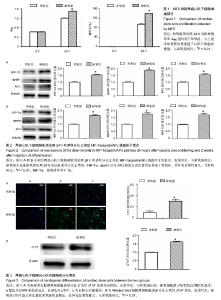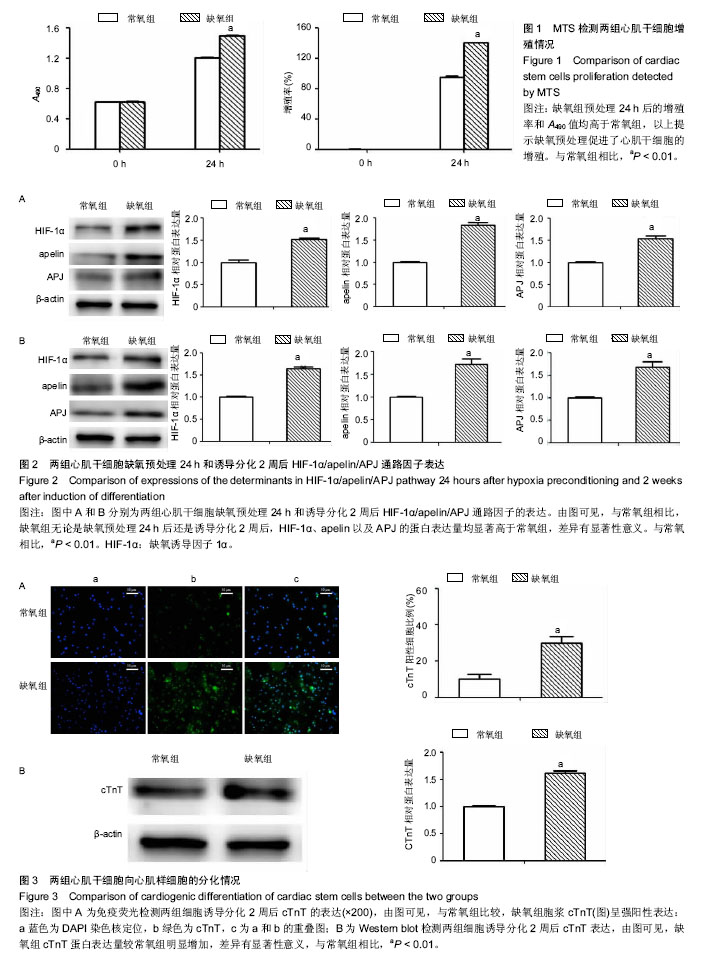| [1] Leong YY, Ng WH, Ellison-Hughes GM, et al. Cardiac Stem Cells for Myocardial Regeneration: They Are Not Alone. Front Cardiovasc Med. 2017;4:47.[2] Zwetsloot PP, Végh AM, Jansen of Lorkeers SJ, et al. Cardiac Stem Cell Treatment in Myocardial Infarction: A Systematic Review and Meta-Analysis of Preclinical Studies. Circ Res. 2016;118(8):1223-1232.[3] Kulandavelu S, Karantalis V, Fritsch J, et al. Pim1 Kinase Overexpression Enhances ckit+ Cardiac Stem Cell Cardiac Repair Following Myocardial Infarction in Swine. J Am Coll Cardiol. 2016;68(22):2454-2464.[4] Zheng SX, Weng YL, Zhou CQ, et al. Comparison of cardiac stem cells and mesenchymal stem cells transplantation on the cardiac electrophysiology in rats with myocardial infarction. Stem Cell Rev. 2013;9(3):339-349.[5] Lee JH, Yoon YM, Lee SH. Hypoxic Preconditioning Promotes the Bioactivities of Mesenchymal Stem Cells via the HIF-1α-GRP78-Akt Axis. Int J Mol Sci. 2017;18(6): E1320.[6] Ng KM, Lee YK, Chan YC, et al. Exogenous expression of HIF-1 alpha promotes cardiac differentiation of embryonic stem cells. J Mol Cell Cardiol. 2010;48(6):1129-1137.[7] Kudová J, Vaší?ek O, ?í? M, et al. Melatonin promotes cardiomyogenesis of embryonic stem cells via inhibition of HIF-1α stabilization. J Pineal Res. 2016;61(4):493-503.[8] Lv B, Hua T, Li F, et al. Hypoxia-inducible factor 1 α protects mesenchymal stem cells against oxygen-glucose deprivation-induced injury via autophagy induction and PI3K/AKT/mTOR signaling pathway. Am J Transl Res. 2017;9(5):2492-2499.[9] Dalzell JR, Rocchiccioli JP, Weir RA, et al. The Emerging Potential of the Apelin-APJ System in Heart Failure. J Card Fail. 2015;21(6):489-498.[10] Wang L, Zhu ZM, Zhang NK, et al. Apelin: an endogenous peptide essential for cardiomyogenic differentiation of mesenchymal stem cells via activating extracellular signal-regulated kinase 1/2 and 5. Cell Biol Int. 2016;40(5):501-514.[11] Kong HL, Li ZQ, Zhao SM, et al. Apelin-APJ effects of ginsenoside-Rb1 depending on hypoxia-induced factor 1α in hypoxia neonatal cardiomyocytes. Chin J Integr Med. 2015;21(2):139-146.[12] Li L, Li L, Zhang Z, et al. Hypoxia promotes bone marrow-derived mesenchymal stem cell proliferation through apelin/APJ/autophagy pathway. Acta Biochim Biophys Sin (Shanghai). 2015;47(5):362-367.[13] Hou J, Yan P, Guo T, et al. Cardiac stem cells transplantation enhances the expression of connexin 43 via the ANG II/AT1R/TGF-beta1 signaling pathway in a rat model of myocardial infarction. Exp Mol Pathol. 2015;99(3):693-701.[14] 钟婷婷,侯婧瑛,郭天柱,等.心肌干细胞短期内改善心肌梗死大鼠心电生理稳定性和室颤阈值[J]. 中国组织工程研究, 2015, 19(28): 4537-4543.[15] 陈立朋,晏平,郭天柱,等.心肌干细胞移植心肌梗死区12周后的心电生理稳定性及室颤阈值改善效应[J]. 中国组织工程研究, 2015, 19(10): 1516-1522.[16] 陈立朋,郭天柱,郑韶欣,等.CSCs和MSCs改进心肌梗死大鼠室颤阈值和心电生理稳定性的对比研究[J]. 中华急诊医学杂志, 2015, 24(9):981-986.[17] 晏平,侯婧瑛,郑韶欣,等.心肌干细胞调控ANG Ⅱ/AT1R/TGF-β1/SMAD/CX43通路改进心电生理学稳定性和室颤阈值[J].中国组织工程研究,2016,20(28):4226-4233.[18] 侯婧瑛,汪蕾,钟婷婷,等. apelin干预骨髓间充质干细胞在缺血缺氧条件下的生存和血管再生[J]. 中国组织工程研究, 2017, 21(1): 6-12. [19] Hou J, Long H, Zhou C, et al. Long noncoding RNA Braveheart promotes cardiogenic differentiation of mesenchymal stem cells in vitro. Stem Cell Res Ther. 2017;8(1):4.[20] Micheu MM, Scafa-Udri?te A, Doroban?u M.Bringing cardiac stem cell therapy from bench to bedside: lessons from the past and future perspectives. Rom J Morphol Embryol. 2016;57(2):367-372.[21] Liu S, Zhou J, Zhang X, et al. Strategies to Optimize Adult Stem Cell Therapy for Tissue Regeneration. Int J Mol Sci. 2016;17(6): E982.[22] Han YS, Lee JH, Yoon YM, et al. Hypoxia-induced expression of cellular prion protein improves the therapeutic potential of mesenchymal stem cells. Cell Death Dis. 2016;7(10):e2395.[23] RajendranNair DS, Karunakaran J, Nair RR. Sub-physiological oxygen levels optimal for growth and survival of human atrial cardiac stem cells. Mol Cell Biochem. 2017;432(1-2):109-122.[24] Kimura W, Xiao F, Canseco DC, et al. Hypoxia fate mapping identifies cycling cardiomyocytes in the adult heart. Nature. 2015 9;523(7559):226-230.[25] Ong SG, Lee WH, Huang M, et al. Cross talk of combined gene and cell therapy in ischemic heart disease: role of exosomal microRNA transfer. Circulation. 2014;130 (11 Suppl 1):S60-69.[26] Bellio MA, Rodrigues CO, Landin AM, et al. Physiological and hypoxic oxygen concentration differentially regulates human c-Kit+ cardiac stem cell proliferation and migration. Am J Physiol Heart Circ Physiol. 2016;311(6): H1509-H1519.[27] Huang M, Nguyen P, Jia F, et al. Double knockdown of prolyl hydroxylase and factor-inhibiting hypoxia-inducible factor with nonviral minicircle gene therapy enhances stem cell mobilization and angiogenesis after myocardial infarction. Circulation. 2011;124(11 Suppl):S46-54.[28] Lee HJ, Jeong CH, Cha JH, et al. PKC-delta inhibitors sustain self-renewal of mouse embryonic stem cells under hypoxia in vitro. Exp Mol Med. 2010;42(4):294-301.[29] Wang Y, Feng C, Xue J, et al. Adenovirus-mediated hypoxia-inducible factor 1alpha double-mutant promotes differentiation of bone marrow stem cells to cardiomyocytes. J Physiol Sci. 2009;59(6):413-420.[30] Wang Y, Sun A, Xue J, et al. Adenovirus-mediated expression of hypoxia-inducible factor 1α double mutant converts neonatal cardiac fibroblasts into (cardio)myocyte phenotype. Cell Biochem Funct. 2012;30(1):24-32.[31] Hou J, Zhong T, Guo T, et al. Apelin promotes mesenchymal stem cells survival and vascularization under hypoxic-ischemic condition in vitro involving the upregulation of vascular endothelial growth factor. Exp Mol Pathol. 2017;102(2):203-209. [32] Zeng X, Yu SP, Taylor T, et al. Protective effect of apelin on cultured rat bone marrow mesenchymal stem cells against apoptosis. Stem Cell Res. 2012;8(3):357-367.[33] Mottaghi S, Larijani B, Sharifi AM. Apelin 13: a novel approach to enhance efficacy of hypoxic preconditioned mesenchymal stem cells for cell therapy of diabetes. Med Hypotheses. 2012;79(6):717-718.[34] Zhang NK, Cao Y, Zhu ZM, et al. Activation of Endogenous Cardiac Stem Cells by Apelin-13 in Infarcted Rat Heart. Cell Transplant. 2016;25(9):1645-1652.[35] Wang IN, Wang X, Ge X, et al. Apelin enhances directed cardiac differentiation of mouse and human embryonic stem cells. PLoS One. 2012;7(6):e38328.[36] Kong HL, Li ZQ, Zhao SM, et al. Apelin-APJ effects of ginsenoside-Rb1 depending on hypoxia-induced factor 1α in hypoxia neonatal cardiomyocytes. Chin J Integr Med. 2015;21(2):139-146.[37] Zhang J, Liu Q, Fang Z, et al. Hypoxia induces the proliferation of endothelial progenitor cells via upregulation of Apelin/APLNR/MAPK signaling. Mol Med Rep. 2016; 13(2):1801-1806. |

